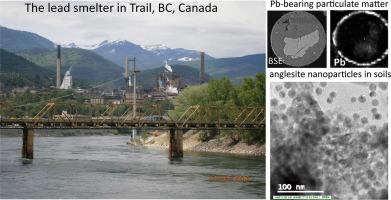Gondwana Research ( IF 6.1 ) Pub Date : 2021-07-17 , DOI: 10.1016/j.gr.2021.07.011 Michael Schindler 1 , M. Santosh 2, 3 , Guilherme Dotto 4 , Luis F.O. Silva 5, 6 , Michael F. Hochella 7, 8

|
Lead (Pb) is one of the most paradoxical elements, both having diverse practical uses, as well as being extremely toxic to humans, and especially to children. The use of Pb records a steady growth with annual production currently exceeding 10 million metric tons. In spite of the environmental awareness of modern society, humans are still exposed to Pb through its emission by smelting and mining activities, and also by Pb-bearing mine wastes and soils. Here, we review the chemical and mineralogical forms of Pb generated from smelting and mining processes and subsequently altered in tailings, slag piles, and soils. In smelter plumes, Pb is emitted to the atmosphere either in the form of smaller nano-size particulate matter (PM) often associated with S, or larger micrometer Pb-bearing PM matter accompanied by oxide-silicate matrices. Pb-bearing phases in mine tailings and impacted soils depict a greater mineralogical and chemical complexity than those emitted from smelters and the larger particle size of this PM also leads to a lower Pb bioavailability. High resolution observations in aquatic system, soils and rock coatings impacted by smelting and mining activities show the presence of Pb-bearing phosphates, sulfides, sulfates, carbonates, and oxide nanoparticles. Larger micrometer size particles of Pb-bearing minerals form often through the aggregation of Pb-bearing nanoparticles, a process commonly referred to as crystallization through particle attachment. Mobilization of Pb within soil columns is strongly affected by the transport of colloids, especially those composed of organic matter and Fe-hydroxides because Pb is taken up efficiently by these two soil components. The extraordinary variability and complexities of all of these processes suggest that future reduction of Pb contamination in the environment and its impact on human health mainly depends on eliminating or greatly reducing Pb-release from smelting operations and tailings impoundments.
中文翻译:

采矿和冶炼活动中释放的含铅纳米颗粒、颗粒物和胶体综述
铅 (Pb) 是最矛盾的元素之一,不仅具有多种实际用途,而且对人类尤其是儿童具有极强的毒性。铅的使用量稳步增长,目前年产量超过 1000 万吨。尽管现代社会有环保意识,但人类仍然通过冶炼和采矿活动排放的铅以及含铅矿山废物和土壤接触铅。在这里,我们回顾了冶炼和采矿过程中产生的铅的化学和矿物学形式,随后在尾矿、矿渣堆和土壤中发生了变化。在冶炼厂的烟羽中,铅以通常与 S 相关的较小纳米颗粒物质 (PM) 或较大微米的含铅 PM 物质的形式排放到大气中,并伴有氧化物-硅酸盐基质。尾矿和受影响土壤中的含铅相比冶炼厂排放的相具有更大的矿物学和化学复杂性,并且这种 PM 的较大粒径也导致较低的铅生物利用度。对受冶炼和采矿活动影响的水生系统、土壤和岩石涂层的高分辨率观察表明,存在含铅磷酸盐、硫化物、硫酸盐、碳酸盐和氧化物纳米颗粒。较大微米尺寸的含铅矿物颗粒通常通过含铅纳米颗粒的聚集形成,这一过程通常称为通过颗粒附着结晶。土壤柱内铅的迁移受到胶体迁移的强烈影响,尤其是那些由有机物和氢氧化铁组成的胶体,因为这两种土壤成分可以有效地吸收铅。


























 京公网安备 11010802027423号
京公网安备 11010802027423号